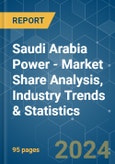The Saudi Arabia Power Market size is estimated at 87.81 gigawatt in 2024, and is expected to reach 116.41 gigawatt by 2029, growing at a CAGR of 5.80% during the forecast period (2024-2029).
This product will be delivered within 2 business days.
Key Highlights
- Over the medium term, factors, such as increasing diversification of energy sources from oil and gas to cleaner energy sources, such as solar, wind, and bioenergy, are expected to drive the Saudi Arabian power market, along with supportive government policies leading to the development of renewable energy capacity during the forecast period.
- On the other hand, the unstable geopolitics of the region is expected to act as a restraint for the market's growth.
- Nevertheless, privatization of the power sector is expected to provide a significant opportunity. If the government capitalizes on this opening, it is likely to help with substantial investments needed to reform the power sector and provide the country with the expertise required to generate renewable energy at lower costs.
Saudi Arabia Power Market Trends
Thermal Power Source to Dominate the Market
- The thermal sources for the country include crude oil and natural gas. In 2021, 355 terawatt-hours (TWh) of electricity was produced from conventional thermal, which accounted for 99% of the total electricity generated in the country.
- The country's power generation is highly dependent on hydrocarbons. At the end of 2021, the country had 10.95 bcm of crude oil production and was second after Venezuela. The country's total natural gas reserves were 117.3 bcm in the same year.
- In recent years, the country saw an increase in electricity from gas-fired power plants, while the country experienced a downfall in power generation from crude oil. This transition was seen due to the country's global movement shifting to cleaner energy sources of energy. In 2021, electricity from oil was 139.9 TWh, while power from natural gas was 215.9 TWh.
- Further, an increase in GDP (Gross Domestic Product) is generally correlated with an increase in electricity consumption. Economic development and electricity consumption are strongly correlated. In Saudi Arabia, electricity demand tends to increase as economic growth occurs. This is primarily because economic activities such as manufacturing, industrial processes, and services require electricity to function. Electricity is required to power machinery, equipment, and infrastructure as industries expand and new businesses emerge. According to General Authority of Statistics, in 2022, GDP of Saudi Arabia reached SAR 4155.56 billion, with growth of 27.58% from the previous year.
- In January 2022, Dhuruma Electricity Company completed the refinancing of USD 1.2 billion for its gas-fired PP11 power plant in Saudi Arabia. PP11 is a 1,730 MW combined-cycle gas-fired power plant near Dhuruma, about 135 km west of Riyadh. The refinancing of the plant ensures the long-term viability of the plant being a reliable thermal power producer in Saudi Arabia.
- Therefore, owing to the abovementioned factors, the thermal power segment will likely dominate the Saudi Arabian power market during the forecast period.
Development of the Renewable Energy Sector to Drive the Market
- The country witnessed a sharp rise in its renewable energy capacity in 2022, mainly driven by the increasing focus on environmental concerns. The total renewable energy installed capacity in 2022 was 443 MW. The country aims to build a renewable energy capacity of 58.7 GW by 2030.
- One of the driving reasons for renewables to increase at such a rate in the country is its plan to reduce oil and gas usage in power generation.
- Saudi Arabia is naturally endowed with renewable energy sources, particularly solar. The solar irradiation in the country is 250 w/m2, which is above the average irradiation of high-potential solar areas globally of 100-200 w/m2.
- The Saudi Arabian Government also encourages many of its large-scale state-owned enterprises to invest in its renewable energy sector. The King Abdullah Petroleum Studies and Research Center (KAPSARC) currently operates a solar energy project with a capacity of 5 MW, comprising over 12,000 panels and covering 55,000 square meters. At the same time, Saudi Aramco also operates a 10.5 MW PV carport system, the world's largest car-park shade, covering 198,350 sq. m and using over 126,000 solar panels. These are the first privately-owned PV projects in the country and are expected to encourage other large corporations to take up private renewable energy projects to reduce emissions and achieve the national target.
- Therefore, owing to the above points, the increasing renewable energy installations and investments in the country are expected to drive the Saudi Arabian power market during the forecast period.
Saudi Arabia Power Industry Overview
The Saudi Arabian Power Market is fragmented. Some of the major players operating in this market (in no particular order) include ACWA Power Co., Saudi Electricity Company (SEC) SJSC, MARAFIQ Power and Water Utility Company for Jubail and Yanbu (MARAFIQ), Arabian Electrical Transmission Line Construction Company (AETCON), and Nour Energy (ASTRA Group), among others.Additional Benefits:
- The market estimate (ME) sheet in Excel format
- 3 months of analyst support
This product will be delivered within 2 business days.
Table of Contents
1 INTRODUCTION
4 MARKET OVERVIEW
5 MARKET SEGEMENTATION
6 COMPETITIVE LANDSCAPE
7 MARKET OPPORTUNITIES AND FUTURE TRENDS
Companies Mentioned (Partial List)
A selection of companies mentioned in this report includes, but is not limited to:
- ACWA Power Co.
- Masdar Abu Dhabi Future Energy Co.
- Electricite de France SA (EDF)
- Saudi Electricity Company (SEC) SJSC
- MARAFIQ Power And Water Utility Company For Jubail And Yanbu (MARAFIQ)
- Engie SA
- Doosan Heavy Industries & Construction Co. Ltd
- Shandong Electric Power Construction Corporation III (SEPCO III)
- Arabian Electrical Transmission Line Construction Company ( AETCON )
- Nour Energy (ASTRA Group)
Methodology

LOADING...










